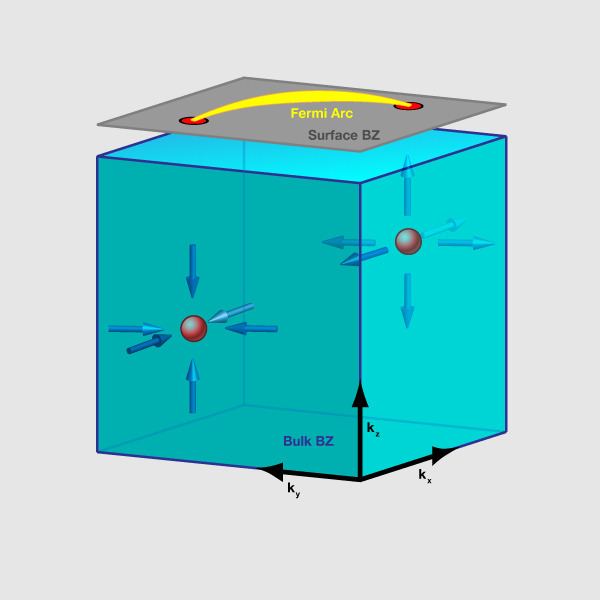 | ||
Weyl fermions are massless chiral fermions that play an important role in quantum field theory and the standard model. They are considered a building block for fermions in quantum field theory, and were predicted from a solution to the Dirac equation derived by Hermann Weyl. For example, one-half of a charged Dirac fermion of a definite chirality is a Weyl fermion. They have not been observed as a fundamental particle in nature. Weyl fermions may be realized as emergent quasiparticles in a low-energy condensed matter system. This was first predicted by C. Herring in the context of electronic band structures of solid state systems such as electronic crystals. The first (non-electronic) liquid state which is suggested has similarly emergent but neutral excitation and theoretically interpreted superfluid's chiral anomaly as observation of Fermi points is in Helium-3 A liquids. Crystalline TaAs is the first discovered topological Weyl fermion semimetal exhibiting topological surface Fermi arcs where Weyl fermion is electrically charged along the line of original suggestion by C. Herring. An electronic Weyl fermion is not only charged but stable at room temperature where there is no such superfluid or liquid state known.
Contents
Experimental discovery of topological Weyl semimetals
A Weyl semimetal is a solid state crystal whose low energy excitations are Weyl fermions that carry electrical charge even at room temperatures. A Weyl semimetal enables realization of Weyl fermions in electronic systems. It is a topologically nontrivial phase of matter, together with Helium-3 A superfluid phase, that broadens the topological classification beyond topological insulators. The Weyl fermions at zero energy correspond to points of bulk band degeneracy, the Weyl nodes(or Fermi points), that are separated in momentum space. Weyl fermions have distinct chiralities, either left handed or right handed. In a Weyl semimetal crystal, the chiralities associated with the Weyl nodes(Fermi points) can be understood as topological charges, leading to monopoles and anti-monopoles of Berry curvature in momentum space, which (the splitting) serve as the topological invariant of this phase. Comparing to the Dirac fermions in graphene or on the surface of topological insulators, Weyl fermions in a Weyl semimetal are the most robust electrons and do not depend on symmetries except the translation symmetry of the crystal lattice. Hence the Weyl fermion quasiparticles in a Weyl semimetal possess a high degree of mobility. Due to the nontrivial topology, a Weyl semimetal is expected to demonstrate Fermi arc electron states on its surface. These arcs are discontinuous or disjoint segments of a two dimensional Fermi contour, which are terminated onto the projections of the Weyl fermion nodes on the surface. A 2012 theoretical investigation of superfluid Helium-3, suggested Fermi arcs in neutral superfluids.
On July 16, 2015 the first experimental observations of Weyl fermion semimetal and topological Fermi arcs in an inversion symmetry-breaking single crystal material tantalum arsenide (TaAs) were made Both Weyl fermions and Fermi arc surface states were observed using direct electronic imaging using ARPES spectroscopy, which established its topological character for the first time. This discovery was built upon previous theoretical predictions proposed in November 2014.
Weyl points(Fermi points) were also observed in non-electronic systems such as photonic crystals and Helium-3 superfluid quasiparticle spectrum (neutral fermions). This article is about Weyl semimetals (electrical conductors).
Crystal Growth, Structure and Morphology
TaAs is the first discovered Weyl semimetal (conductor). Large-size (~1 cm), high-quality TaAs single crystals can be obtained by chemical vapor transport method using iodine as the transport agent.
TaAs crystallizes in a body-centered tetragonal unit cell with lattice constants a = 3.44 Å and c = 11.64 Å and the space group is I41md (No. 109). Ta and As atoms are six coordinated to each other. It should be noted that this structure lacks a horizontal mirror plane and thus inversion symmetry, which is essential to realize Weyl semimetal.
TaAs single crystals have shiny facets, which can be divided into three groups: the two truncated surfaces are {001}, the trapezoid or isosceles triangular surfaces are {101}, and the rectangular ones {112}. TaAs belongs to point group 4mm, the equivalent {101} and {112} planes should form a ditetragonal appearance. The observed morphology can be vary of degenerated cases of the ideal form.
Applications
The Weyl fermions in the bulk and the Fermi arcs on the surfaces of Weyl semimetals are of interest in physics and materials technology. The high mobility of charged Weyl fermions may find use in electronics and computing.
